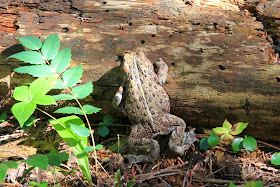Left: A Swim in Hidden Lake; Right: Bufo borealis – Western Toad
The Hidden Lake Hike is a short jaunt (1.2 miles) to Hidden Lake located just south the western end of Lake Wenatchee. (After a challenging hike up to Aasgard Pass the previous day, this was a welcome relief.) Judging by the number of people we saw with towels, it is popular to take a dunk in. Of the six of us, four of us went in for a dip. The kids were fascinated with the little fish that swam around our feet as we cooled our toes on the lake’s edge.
Here are a couple of plants and animals we saw on the trip back and forth to the lake.
Bufo borealis, Western Toad. This is the first time we have seen one of these guys. We think we saw him twice, once on the way to the lake and once on the way back. He just hopped along at a leisurely pace, slightly annoyed we were watching him.
Sorbus scopulina, Western Mountain-Ash shrub. I think this is S. scopulina based on the sharp-pointed leaflets of the compound leaf as compared to S. sitchensis with more rounded leaflets at the tips and being toothed from middle to end.
Paxistima myrsinites, Oregon Boxwood. For this etymology, I found this interesting information at the US Forest Service Celebrating Wildflowers site:
The exact etymology and correct spelling of the genus have been debated for nearly two centuries. Most scholars assume the name comes from the Greek words “pachys” for thick (think of a thick-skinned elephant, or pachyderm) and stigma, in reference to the somewhat thickened stigma of the flower. Rafinesque and others have variously spelled the name as Pachistma, Pachystima, and Pachystigma, although Rafinesque’s original spelling of Paxistima is the name most widely accepted today. The species epithet, myrsinites, also comes from the Greek for “myrrh”, which the Mountain-lover’s tiny flowers are said to resemble in scent.
Rosa gymnocarpa, Baldhip Rose growing in shady damp spots along the trail. The specific name derives from the Greek gymno meaning “naked” and carpa meaning “fruit” and refers to the fact the sepals fall away from the fruit unlike other rose hips.
Symphoricarpos albus, Common Snowberry. The generic name derives from the Greek symphorein meaning “to bear together” and carpos meaning “fruit” and refers to the fact that berries are often packed closely together. The specific name albus means “white”.
Left: Rosa gymnocarpa - Baldhip Rose; Right: Symphoricarpos albus - Common Snowberry
Back at the nearby cabin we were staying at, we found some more interesting bits of nature: a lizard, a large insect, and some berries and flowers.
We posed a Sceloporus occidentalis, Western Fence Lizard(found dead in a bathtub) with a Ergates spiculatus, Ponderous Borer Beetle (found dead in the garage). A bit of trivia or at least an interesting story: the site of artist and novelist Barb Bentler Ullman mentions that “The sawing jaws of the larvae are said to have inspired the design of the chain saw.” No wonder we found it in the garage.
Around the house, we found Sambucus cerulea, Blue Elderberry and Achillea millefolium, Common Yarrow.
Sceloporus occidentalis - Western Fence Lizard and Ergates spiculatus – Ponderous Borer Beetle. Just a hint of blue on the belly of the lizard gives us a clue to one of its common names “Blue-Belly”.
Left: Sorbus scopulina – Western Moutain-Ash; Center: Sambucus cerulea – Blue Elderberry and Achillea millefolium – Yarrow; Right: Paxistima myrsinites – Orgeon Boxwood
Left: Topo Map (Google) of the Hidden Lake Trail; Right: Two Bumps Boys on a Log










No comments:
Post a Comment
All comments are moderated. If your comment doesn't appear right away, it was likely accepted. Check back in a day if you asked a question.